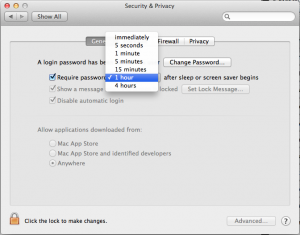The Macbook I got for work is configured to require the password after the screensaver turns on or the display goes to sleep. By default, the screen is set to sleep after 2 minutes of inactivity on battery and 10 minutes on power adapter. When I work on two computers, alternating between the Macbook and a desktop, I hate having to keep inputting the password on the Macbook to unlock it.
I understand the need for security, but I draw the line when it makes using the Macbook too inconvenient. I don’t want to eliminate the password requirement, I just want the screen locks (which require the password to exit from) not to occur so often.
I considered adjusting the power settings so that the Macbook won’t go to sleep until an hour of inactivity occurs on either battery or power adapter. (Likewise, changing the screen saver to wait an hour.) However, making such a change would cause the battery usage to increase (the display uses a lot of power) and require a shorter interval between charges. (To preserve the battery capacity, I usually use the battery until it is very low before charging. And when charging, I try to give it an opportunity to charge to 100 percent.) While I don’t use the Macbook differently on battery versus power adapter, having to charge and being tethered to the wall socket more often is inconvenient.
 I found the solution in “System Preferences”, under the “Security & Privacy” section. There is an option named “Require password [time interval] after sleep or screen saver beings” that controls when the screen lock activates. I changed the time interval from the initial 5 seconds to 1 hour. (There are 7 selectable time intervals ranging from immediately to “4 hours”.) Now, when the screen saver runs or the Macbook goes to sleep (for example, when I close the lid), I don’t need to input the password when I wake the Macbook before the 1 hour interval expires.
I found the solution in “System Preferences”, under the “Security & Privacy” section. There is an option named “Require password [time interval] after sleep or screen saver beings” that controls when the screen lock activates. I changed the time interval from the initial 5 seconds to 1 hour. (There are 7 selectable time intervals ranging from immediately to “4 hours”.) Now, when the screen saver runs or the Macbook goes to sleep (for example, when I close the lid), I don’t need to input the password when I wake the Macbook before the 1 hour interval expires.
This setting gave me a good compromise between security and convenience. I am not required to input the password for any inactivity less than an hour and I can leave the power (and screen saver) settings on battery conservation mode.
But what if I need to put the Macbook immediately into screen lock mode? The answer surprisingly lies in the “Keychain Access” application. To support manually locking the Mac, do the following:
- Run the “Keychain Access” application (under /Applications/Utilities directory).
- Go to the “Keychain Access” menu, Preferences, General, and check the “Show keychain status in menu bar” option.
You should now see a lock icon on the top-right menu bar. When you want to manually lock the Mac, click on the lock icon and select “Lock Screen”.
Hopefully the above will help you to secure your Mac without making it too inconvenience to use.
Note: The “Lock Screen” method above was gotten from Quickly lock your screen. Unfortunately, on Mac OS X Mountain Lion, the re-arrange menu bar icon function (hold Cmd and drag icon left or right) didn’t work so I was not able to get a keyboard shortcut working for “Lock Screen”.
